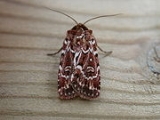
True Lover's Knot
Encyclopedia
The True Lover's Knot (Lycophotia porphyrea) is a moth
of the family Noctuidae
. It has a nearly cosmopolitan distribution. In Europe
it is found wherever its food plants grow. It is traditionally thought of as a species of heathland and moorland
but it can often be found in places where heather
and its relatives are in garden cultivation.
This is a small but attractive species, with a wingspan of 26–34 mm (individuals hatched in higher altitudes tend to be smaller than those from the lowlands). The forewings are brown, often tinged with purple and marked with a complex pattern of white markings which are supposed to recall a true lover's knot
. The hindwings are grey or buff. It flies from the latter half of June to the beginning of August and is attracted to light and the flower
s of its food plants.
The larva
is reddish-brown with pale lines and feeds on heather and related genera (e.g. Erica
). The species overwinters as a larva.
Moth
A moth is an insect closely related to the butterfly, both being of the order Lepidoptera. Moths form the majority of this order; there are thought to be 150,000 to 250,000 different species of moth , with thousands of species yet to be described...
of the family Noctuidae
Noctuidae
The Noctuidae or owlet moths are a family of robustly-built moths that includes more than 35,000 known species out of possibly 100,000 total, in more than 4,200 genera. They constitute the largest family in the Lepidoptera....
. It has a nearly cosmopolitan distribution. In Europe
Europe
Europe is, by convention, one of the world's seven continents. Comprising the westernmost peninsula of Eurasia, Europe is generally 'divided' from Asia to its east by the watershed divides of the Ural and Caucasus Mountains, the Ural River, the Caspian and Black Seas, and the waterways connecting...
it is found wherever its food plants grow. It is traditionally thought of as a species of heathland and moorland
Moorland
Moorland or moor is a type of habitat, in the temperate grasslands, savannas, and shrublands biome, found in upland areas, characterised by low-growing vegetation on acidic soils and heavy fog...
but it can often be found in places where heather
Calluna
Calluna vulgaris is the sole species in the genus Calluna in the family Ericaceae. It is a low-growing perennial shrub growing to tall, or rarely to and taller, and is found widely in Europe and Asia Minor on acidic soils in open sunny situations and in moderate shade...
and its relatives are in garden cultivation.
This is a small but attractive species, with a wingspan of 26–34 mm (individuals hatched in higher altitudes tend to be smaller than those from the lowlands). The forewings are brown, often tinged with purple and marked with a complex pattern of white markings which are supposed to recall a true lover's knot
True lover's knot
The true lover's knot is a name which has been used for many distinct knots. The association of knots with the symbolism of love, friendship, and affection dates back to antiquity...
. The hindwings are grey or buff. It flies from the latter half of June to the beginning of August and is attracted to light and the flower
Flower
A flower, sometimes known as a bloom or blossom, is the reproductive structure found in flowering plants . The biological function of a flower is to effect reproduction, usually by providing a mechanism for the union of sperm with eggs...
s of its food plants.
The larva
Larva
A larva is a distinct juvenile form many animals undergo before metamorphosis into adults. Animals with indirect development such as insects, amphibians, or cnidarians typically have a larval phase of their life cycle...
is reddish-brown with pale lines and feeds on heather and related genera (e.g. Erica
Erica
Erica ,the heaths or heathers, is a genus of approximately 860 species of flowering plants in the family Ericaceae. The English common names "heath" and "heather" are shared by some closely related genera of similar appearance....
). The species overwinters as a larva.
Reading
- Chinery, Michael Collins Guide to the Insects of Britain and Western Europe 1986 (Reprinted 1991)
- Skinner, Bernard Colour Identification Guide to the Moths of the British Isles 1984

